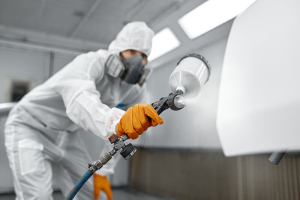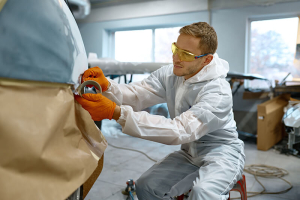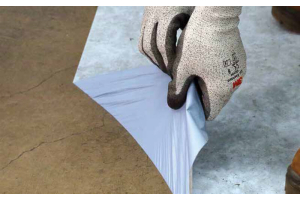Do You Know About These Latest Changes In Masking Tape?
Are You Keeping Up With The
Latest Improvements In Masking Tape?
When it comes to painting, there's nothing worse than spending hours getting the paint nice and even - only to see wavy, blurry lines when you pull the tape off. In order to get those beautiful, smooth, sharp lines, you need to be using the best masking tape for your specific product.
While it's easy to just grab whatever has worked for you in the past, it's probably time for an upgrade. After all, masking tape has come a long way in recent years and it can make your job a lot easier.
Like all products, masking tape has changed. It may have a softer adhesive or a thinner backing - and the cost has definitely gone up. All changes that probably aren't the best for your current process.
So, let's see what's changed and if there's a better product out there for you:
Goodbye Tan - Hello Colors!
The first thing you'll notice about today's masking tape is that it's available in practically every color of the rainbow. This isn't just an aesthetic change - those colors signify different products. So what does each color mean?
2090 Blue Tape
Let's start with 2090 blue. The key differentiator here is that it's an acrylic adhesive that can survive outdoor exposure for two weeks. It's also great for using with delicate surfaces like wallpaper because it has a lower tack level.
One caution - when you peel the tape off, be sure to check for an almost invisible residue that attracts dirt. This is caused by the soft, UV-resistant adhesive. To help prevent this, don't leave it on for more than a day. This product is very good for home projects - as long as you don't leave it on for too long!
2080 Blue Tape
Similar to the 2090 is the 2080, a different version of blue tape which has a very thin rice paper stock paper backing. It's a flat back tape, meaning the paper is not creped to allow for flexing around a radius. This is a plus because a crepe backing requires more adhesive on the backing to adequately resist paint bleed under the edge. With less adhesive on the 2080, you'll get a more precise fine line.
Like the 2090, you need to remove it as soon as possible to avoid leaving a residue. For products that require you to do two-tone paint, remove the residue with solvent so that you don't get a bumpy surface where the tape was. (In this case, I'd use one of the new Plus series masking tapes.)
Understanding The 3M Family Of Masking Tapes
As the largest manufacturer of masking tapes, 3M has an option for almost any product. They are constantly researching their formulas to improve results, cut costs and offer the best products on the market.
They number all their product sequentially and use a plus sign to show you which are the new and improved products. Before I share the results of my unofficial test with you, let's learn more about each tape I tested:
The 101+ Masking Tape Family
Let's start with the least expensive and lowest part number - the 101+. Known as a general purpose tape, it has a traditional rubber adhesive that is very sticky. The paper backing has minimal crepe, with just enough to make it slightly resistant to edge tearing.
A very basic option, it can stand up to 150°F but we recommend that you don't expose it to that high of a temperature. It's best used for bundling, tabbing, labeling and more. It did pass my rattle can spray paint test of various enamel and lacquer paints.
When I removed the tape, it left a bleary line. It did resist the solvents and peeled off cleanly five days later, which is a plus. Overall, I don't recommend using this tape for paint masking because it's thin and hard to keep flat when using long runs of tape. The adhesive is also grabby and isn't a good fit for delicate surfaces like wallpaper or paint.
The 201+ Masking Tape Family
The line of masking tape products is the 201+ family. It's also a general use tape, designed for indoor light to medium duty applications. It looks like the traditional tan masking tape you're used to, but it's thinner, lower tack and has a weaker backing.
In my rattle can test, it survived the full gamut of paints with nice clean paint lines. I did find that the paint didn't stick to the paper backing and instead, it just flaked off. One caution here - this may cause paint chips to flake off and fall into your wet paint, so be careful when using.
According to the tech data, this tape is able to withstand up to 30 minutes in a 200°F bake cycle. It also has the new solvent-free rubber adhesive - something it shares with its more expensive brothers 301+ and 401+ - so overall I recommend this product if you're looking for an entry-level masking tape. It will help you get a clean edge when you aren't using exotic paints with strong solvents. So, if you're using spray paint, latex, oil-based enamels and varnish, this is a good choice.
The 301+ Masking Tape Family
Now let's take a look at the 301+, a bright yellow tape that is frankly impossible not to notice. Although this can be a plus when you're working on a big project, it's really more of a marketing play than a functional one.
Like the 201+, it's solvent free but is thicker and tackier and offers the best break resistance of the family. It can take up to 225°F for 30 minutes and is supposed to be able to stick to irregular surfaces.
Originally introduced as a lower-priced body shop tape, it leaves a crisp, clean line when used for painting. In addition to auto shop work, it can also be used in marine painting applications. It's especially good with linear urethane paint and gelcoat.
It's less expensive than the 2090 blue tape, but since it won't leave any residue when used indoors, it makes sense to avoid acrylic formulas unless you need to leave your project outdoors for several days.
The 401+ Masking Tape Family
The last tape we will discuss in this family is 401+ green. This tape is very similar to the 301+, except the adhesive is able to withstand up to 30 minutes at 250°F, which is still really not much of an oven cure.
Compared to the 301+ tape, the tack, tensile and thickness are all higher. It's designed for superior adhesion to rubber, plastic, glass and metal. It's best for products that have a fussy marine varnish and high solvent anti-fouling bottom paint where high solvent resistance is needed.
And if you're looking for a good, all-purpose tape, I'd recommend this one. Although it costs a little more, it's good to keep on hand for a variety of projects.
The Right Tape For The Job
So these are your best options for most manufacturing uses. If paint lines are critical, I'd recommend a “fine line” masking tape, which are much thinner and are built to take curves flat without puckering. This helps create extremely crisp edges with minimal paint build up at the edge.
Ready To Learn More?
Have more questions? Check out our masking tape page to learn more about how to use it in your manufacturing operations.
See Why We're The Top Supplier For Industrial, Marine and Safety
30-Second Summary:
- ✔ 3M is the leading masking tape manufacturer, and offers a comprehensive line of tapes for every painting purpose.
- ✔ There are two blue tapes - the 2090 and the 2080. The 2090 is an acrylic adhesive that can survive outdoor exposure for two weeks. The 2080 has a very thin rice paper stock paper backing and creates a more precise line.
- ✔ The 101+ is a general purpose tape that's best used for bundling, tabbing, labeling and more.
- ✔ The 201+ is also a general use tape, designed for indoor light to medium duty applications.
- ✔ The 301+ was originally introduced as a lower-priced body shop tape and it leaves a crisp, clean line when used for painting.
- ✔ The 401+ is designed for superior adhesion to rubber, plastic, glass and metal.












